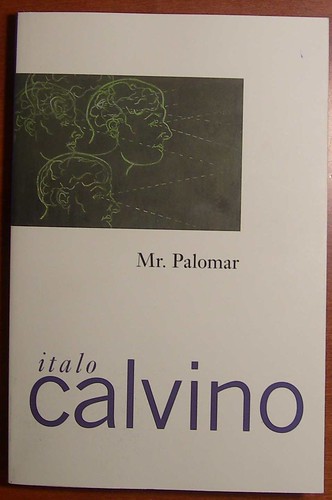by Italo Calvino, 1983
126pp
Read: 3/27 - 3/30
I'll start with the "Index":

You'll notice that it's more of a table of contents or schemata. The book is arranged by three's: its three sections, "Mr. Palomar's Vacation," "Mr. Palomar in the City," and "The Silences of Mr. Palomar," are each divided into three subsections, each of which consists of three scenes. So, twenty-seven parts.
But observe the coordinate system on the left. Those numbers, Calvino explains, correspond to different modes of perception or experience (he's a little unclear here, and I think that the translation probably does his ideas some disservice). Roughly, 1 = Observation (particularly of aggregations), 2 = Anthropology (as well as semiotics, apparently), and 3 = Meditation. Roughly, I suppose he's trying to establish a hierarchy: one's relation to objects --> one's relation to society --> one's relation to the universal. So, for example: 1.3.3, "Mr Palomar's Vacation: Mr. Palomar Looks at the Sky: The contemplation of the stars" is two parts "meditation" to one part "observation." Or that's how it ought to work.
So the book works less like a novel than a series of essays. Mr. Palomar observes the things around him (hence the observatory reference), and he reflects on these things. In reading it, I experienced a fair deal of synchronicity, despite the unlikely objects of Mr. Palomar's observations: I read his meditation on "The loves of tortoises" just before seeing a picture of copulating turtles; "The infinite lawn" likewise resembled a friend's comments about his own lawn, and "The order squamata" reminded me of a museum exhibit I'm planning on taking a certain three year-old to.
Strangely, for a book that's so much about the interaction between ego and the outer world, we don't really get to know Mr. Palomar. Though we constantly hear his observations and meditations, the traditional avenues of characterization (interactions with other characters, seeing him make decisions) are largely closed to him. Consequently Palomar feels a bit like Mr. Magoo, a comic character whose interior life we can only intuit.

The covers of the Harcourt Brace editions of Italo Calvino all sport these rather straightforward illustrations of the book in question, all by one Shelton Walsmith. It's always kind of fun to see how he manages to capture a piece of experimental fiction in ten square inches.

No comments:
Post a Comment